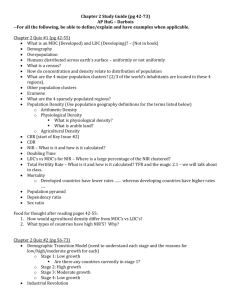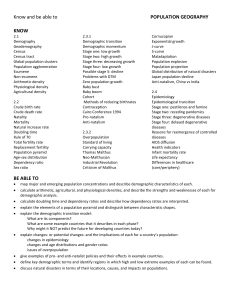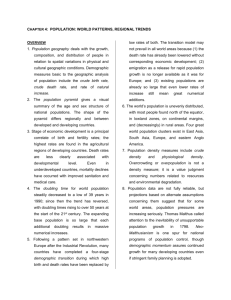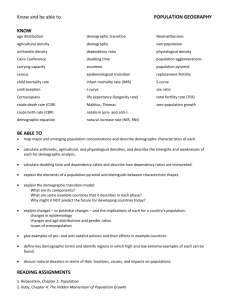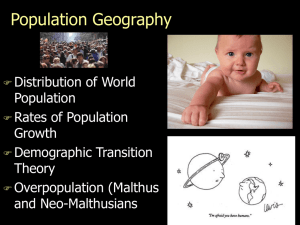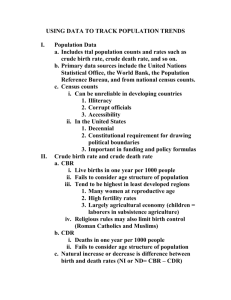Chapter 2: Population Chapter Outline Introduction. Understanding
advertisement
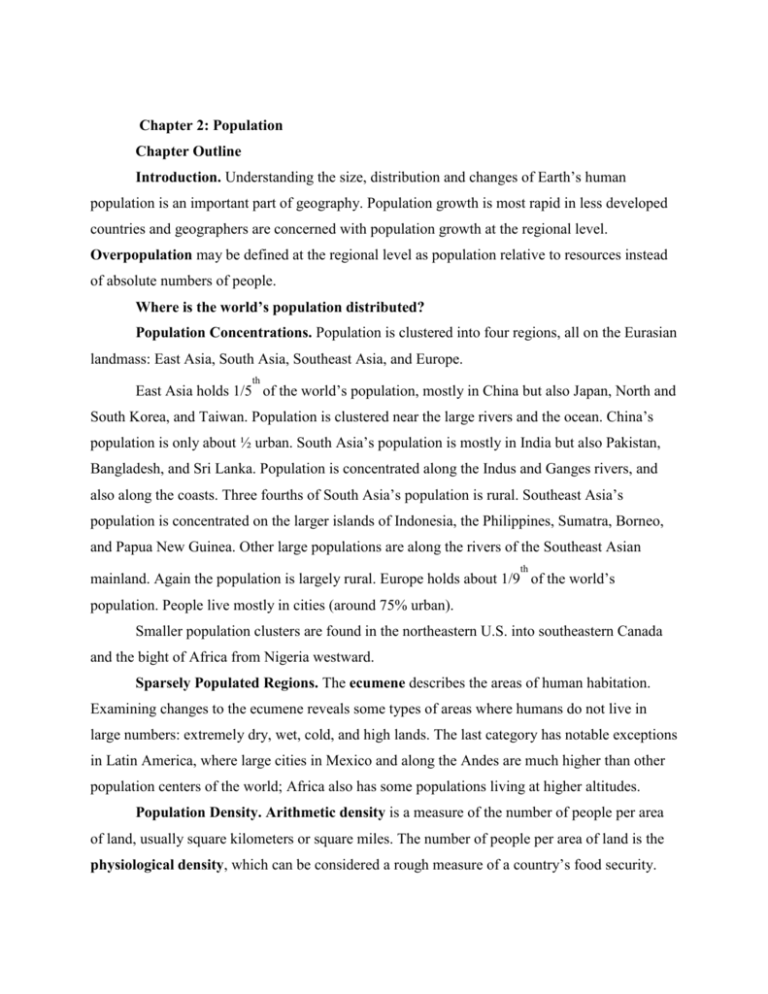
Chapter 2: Population Chapter Outline Introduction. Understanding the size, distribution and changes of Earth’s human population is an important part of geography. Population growth is most rapid in less developed countries and geographers are concerned with population growth at the regional level. Overpopulation may be defined at the regional level as population relative to resources instead of absolute numbers of people. Where is the world’s population distributed? Population Concentrations. Population is clustered into four regions, all on the Eurasian landmass: East Asia, South Asia, Southeast Asia, and Europe. th East Asia holds 1/5 of the world’s population, mostly in China but also Japan, North and South Korea, and Taiwan. Population is clustered near the large rivers and the ocean. China’s population is only about ½ urban. South Asia’s population is mostly in India but also Pakistan, Bangladesh, and Sri Lanka. Population is concentrated along the Indus and Ganges rivers, and also along the coasts. Three fourths of South Asia’s population is rural. Southeast Asia’s population is concentrated on the larger islands of Indonesia, the Philippines, Sumatra, Borneo, and Papua New Guinea. Other large populations are along the rivers of the Southeast Asian th mainland. Again the population is largely rural. Europe holds about 1/9 of the world’s population. People live mostly in cities (around 75% urban). Smaller population clusters are found in the northeastern U.S. into southeastern Canada and the bight of Africa from Nigeria westward. Sparsely Populated Regions. The ecumene describes the areas of human habitation. Examining changes to the ecumene reveals some types of areas where humans do not live in large numbers: extremely dry, wet, cold, and high lands. The last category has notable exceptions in Latin America, where large cities in Mexico and along the Andes are much higher than other population centers of the world; Africa also has some populations living at higher altitudes. Population Density. Arithmetic density is a measure of the number of people per area of land, usually square kilometers or square miles. The number of people per area of land is the physiological density, which can be considered a rough measure of a country’s food security. The number of farmers per area of arable land, the agricultural density, is a measure of development as machines are used in more developed countries. Where has the world’s population increased? Natural Increase. Population growth is measured through the natural increase rate (NIR, also commonly referred to as the rate of natural increase). The NIR is calculated by subtracting the crude death rate from the crude birth rate. The NIR is given as a percent change per year, while birth and death rates are usually given per 1,000 total population. World NIR has decreased from a 1963 peak of 2.2 to around 1.2 percent, lessening concerns about rapid population growth. Still, the average masks large regional differences: most growth is occurring in less developed countries while more developed countries have low or even slightly negative growth. These regional differences map out for a variety of demographic measures. Fertility. The total fertility rate (TFR) is a measure of the average number of children a woman will have in her lifetime; it ranges from less than 2 to over 6. Mortality. Other measures of mortality include the infant mortality rate (IMR, deaths before age 1 per 1,000 live births, ranging from under 10 to over 100) and life expectancy at birth, the average number of years a person born today can expect to live. Life expectancy ranges from around 40 years to around 80 years. Note that the crude death rate does not follow the global distribution of other indicators. This is because crude death rates are relatively high in places with a large proportion of elderly people. Thus, the crude death rate is not an indicator of development. Why is population increasing at different rates in different countries? The Demographic Transition. The demographic transition is a The Demographic Transition. The demographic transition is a model of population change where high birth rates and death rates transition to low birth rates and death rates. It is divided into four stages: In stage 1, birth rates and death rates are both high, resulting in a low rate of growth. There are no countries presently in stage 1. The move to stage 2 is caused by a decline in death rates. Birth rates remain high, leading to rapid population growth. The more developed countries entered stage 2 as a part of the Industrial Revolution, while many less developed countries entered stage 2 much later as a result of the diffusion of medical technologies and knowledge into the less developed world (the medical revolution). Stage 3 is marked by a drop in fertility, which brings down the birth rate and decreases the natural increase rate. The death rate continues to fall but not as rapidly as the birth rate. Stage 4 is marked by a low crude birth rate and crude death rate and nearly zero natural increase. Stage 4 resembles stage 1 in terms of growth but otherwise is very different: instead of high birth and death rates, both are low. Life expectancies are much longer in stage 4, and society is much different. Finally, once the demographic transition has reached stage 4, the population has swelled during stages 2 and 3. Population Pyramids. Population pyramids give a “snapshot” of the age and sex composition of a population. We can tell at one look whether a population is growing rapidly (wide base), has a long or short life expectancy (tall or short pyramid), or is aging and stable (straight sides). Two measures are illustrated in the population pyramid: the dependency ratio and the sex ratio. The dependency ratio is the ratio of those too young or too old to work to those of working age. The sex ratio is the number of men per 100 women. Countries in Different Stages of Demographic Transition. This section gives representative examples of countries in each stage of the demographic transition: Cape Verde (stage 2), Chile (stage 3), and Denmark (stage 4) Demographic Transition and World Population Growth. Those concerned with the progress of the demographic transition in rapidly growing countries today are faced with a special challenge. It took European and North American populations 100 years or more to make the transition out of stage 2, which is caused by a cultural change to preferring smaller families. Not only are developing countries being asked to make the transition faster, the cause of their movement into stage 2 is fundamentally different from historic causes. In many cases it is unknown whether the move to stages 3 and 4 will happen soon or not. Contemporary Geographic Tools: Spatial Analysis and the Census. This box briefly covers the decennial U.S. census and measurement issues associated with population counts in general. Global Forces, Local Impacts: Japan’s Population Decline. Japan has the somewhat unique combination of a negative natural increase rate coupled with a strict immigration policy. This means that Japan’s population is aging with potential problems in the future because so few children are being born. Why might the world face an overpopulation problem? Malthus on Overpopulation. Thomas Malthus predicted that population increases would soon outpace the potential increases in food supply, leading to dramatic crises as a result of this strain on resources. Malthus was wrong for his time period but his thesis remains attractive to many today who point out that today’s projected numbers may create a resource crisis for food supply or some other resources (like fresh water or energy). Critics of Malthus argue that population growth is not so large that human ingenuity or cooperation cannot overcome any resource hurdles which arise. Declining birth rates. Birth rates have continued to decline across the world but especially in developing countries. Most of this decline has been to declining birth rates, attributable to economic development and increased use of contraceptives. Debate continues on the most effective means to lower birth rates. World Health Threats. Unfortunately, increasing death rates have contributed to lower growth rates in some areas of the world, most notably portions of sub-Saharan Africa affected by the AIDS epidemic. The epidemiologic transition roughly follows the demographic transition but instead of changes in birth rates it tracks changes in the leading causes of death. In the epidemiologic transition stages 1 and 2, death from contagious disease is at first common and then gradually less so. By stage 3, contagious diseases are less common and chronic diseases like cardiovascular disease and cancer. In stage 4 lives are extended—for example, heart attacks and cancer become survivable through medical treatment. Some epidemiologists predict a stage 5, where death rates increase again as contagious diseases return. AIDS has been the most deadly recent epidemic, having killed over 25 million.

